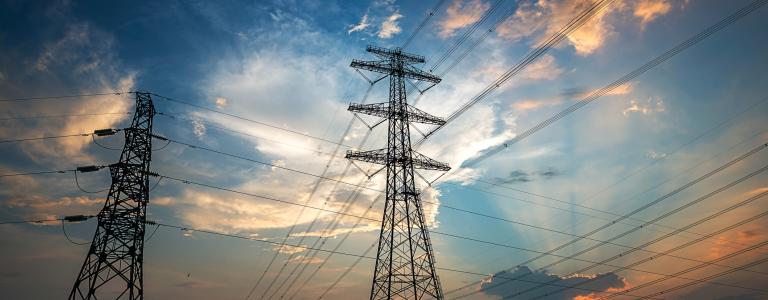Reactions to Canada's Climate Change Framework: Electricity
In the second of a series of blog posts on the Pan-Canadian Framework on Clean Growth and Climate Change, Phil Gass explores what the framework will mean for the electricity sector.
In December 2016 Canada's First Ministers released their Pan-Canadian Framework on Clean Growth and Climate Change. In this series of blog posts, we break down the framework for you, explaining what is proposed, what the strengths are and what challenges may lie ahead.
In this blog post we focus on electricity.
What is the issue?
In 2014 about one tenth of Canada’s greenhouse gas (GHG) emissions came from electricity. About 80 per cent of Canada's electricity is already non-emitting, thanks to a large abundance of hydroelectricity and policies that have supported renewable energy sources, such as wind and solar electricity.
A number of jurisdictions across Canada have moved away from, or are in the process of moving away from, coal electricity in order to reduce GHGs and improve local air quality and human health. Ontario has already phased out coal electricity. Alberta will phase out emissions from coal-fired electricity while requiring a minimum 30 per cent electricity generation from renewable sources by 2030. A robust plan to phase out coal emissions in Saskatchewan is still needed.
Challenges in a post-coal world include: avoiding a quick switch to gas; getting clean electricity to the regions, provinces and local communities that need it; and ensuring efficient and effective support for renewable energy.
Reducing emissions from electricity must be a short-term focus for Canada, as we identify ways to address emissions in other sectors that will require a longer-term strategy.
How does the Pan-Canadian Framework plan to address the problem?
The framework’s clean electricity component has four key elements:
- Increasing renewables and low-emitting sources.
- Connecting clean power to the places that need it.
- Modernizing electricity systems.
- Reducing reliance on diesel in Indigenous, northern and remote communities.
Outside of commitments to accelerate coal phase-out and intent to develop performance standards for natural gas, details are noticeably absent in the framework.
What are the strengths of the proposed solutions?
The framework hits the right notes on the need to accelerate the phase-out of coal from the Canadian electricity grid while integrating renewables into the sector.
While it will have a small overall impact on national emissions, the commitment to help communities get off diesel power will be pivotal in providing equal access to clean power and reducing the potential for negative environmental impacts (e.g., spills). In some communities this may include connection to larger grids, while off-grid renewables may be part of the solution in others.
Performance standards for natural gas may reduce the emission intensity of natural gas-fired electricity generation. Natural gas is, at best, a bridging fuel, and should be treated as such. Avoiding the lock-in of fossil fuels will be necessary to meet mid-century emission reduction objectives.
What are some key elements to consider in implementing a robust policy?
Smart policy making in the electricity sector should include expansion of electricity grids to promote clean energy trade and considerations to minimize the impact that supports for renewables will have on rate payers.
Improved connectivity of electricity grids across provinces and to the United States could create economic opportunities while helping individual provinces and our neighbours to the south phase out coal.
Smart renewables policies should be designed to help technologies achieve economic competitiveness without over-subsidizing them, which can lead to higher electricity costs for residents and businesses. With rapid expansion of renewables, governments should also have a robust environmental assessment process.
Finally, federal, provincial and territorial governments need to pay close attention to fossil fuel subsidies for electricity and heating sources. Reform and elimination of fossil fuel energy consumption subsidies should be a part of the framework, in line with existing commitments to reform subsidies under the G20 commitment.
You might also be interested in
Canadians on the Hook for up to CAD 18.8 Billion in Ongoing Subsidies to the Trans Mountain Pipeline
Canadian taxpayers could end up contributing up to CAD 18.8 billion in subsidies to the Trans Mountain Pipeline if the federal government continues charging discounted transportation tolls to the oil industry, according to a new IISD report.
For Nature-Based Solutions to Be Effective, We Need to Work with Indigenous Peoples and Local Communities
Nature-based solutions have been praised as a promising approach to tackling the twin crises of climate change and biodiversity loss. But some Indigenous Peoples and local communities are questioning the legitimacy of the concept and what it symbolizes. It is time to listen to what they have to say.
Global Dialogue on Border Carbon Adjustments
This report contributes to the global BCA discussion by summarizing country-level reports reflecting dialogues conducted in Brazil, Canada, Trinidad and Tobago, the United Kingdom, and Vietnam.
Volatile Costs of Fossil Fuel Energy were a Key Driver of Recent Record Inflation and Continue to Impact Affordability
New report takes closer look at how Canada’s dependence on fossil fuels impacts energy costs and prices of essentials such as transportation, home heating, and housing.
